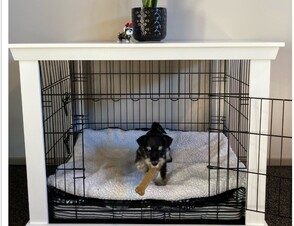Crate training is an effective method for toilet training and providing a safe space for your puppy. Here are 8 simple steps to crate train a puppy:
Choose the right crate: Select a crate that is appropriate for your puppy's size. It should be large enough for them to stand, turn around, and lie down comfortably. However, it shouldn't be too big, as they may be inclined to eliminate in one corner and sleep in another. How to choose a crate that is the right size for your puppy?
Introduce the crate gradually: Make the crate a positive and inviting space for your puppy. Leave the door open and place some treats, toys, and a soft blanket inside. Allow your puppy to explore the crate at their own pace without any pressure.
Associate positive experiences: Encourage your puppy to enter the crate by tossing treats or toys inside. You can also feed them their meals near the crate, gradually moving the food inside over time. Create positive associations by providing praise and rewards whenever they voluntarily go inside the crate.
Start with short periods: Once your puppy is comfortable going in and out of the crate, start closing the door for short durations. Stay nearby and offer them treats and verbal praise through the crate door. Gradually increase the length of time they spend inside, always ensuring they are comfortable and not exhibiting signs of distress.
Establish a routine: Create a consistent schedule for crate time, including periods for meals, naps, and quiet rest. Dogs thrive on routines, and having a predictable schedule will help them understand when it's time to go into the crate and when it's time to come out.
Avoid punishment: Never use the crate as a form of punishment. It should be a positive and safe space for your puppy. Using the crate for time-outs or as a disciplinary measure can create negative associations and hinder the training process.
Gradual separation: Once your puppy is comfortable spending longer periods in the crate with the door closed, start stepping away for short durations. Begin by moving a few steps away, Then gradually increase the distance and time you spend apart. Return before your puppy shows signs of distress to reinforce that being in the crate is not a negative experience.
Night time routine: At night, place the crate in your bedroom or nearby so your puppy feels secure and can hear your presence. Create a cozy environment inside the crate by covering the top and sides partially with a lightweight blanket or Crate Cover. This creates a den-like atmosphere and can help reduce visual stimulation, making the crate feel more secure. This will help your puppy feel more at ease and reduce the likelihood of excessive whining or barking. Shop Crate Cover - Made in NZ
Remember, crate training takes time and patience. Each puppy is different, so the speed of progress may vary. By following these steps consistently and providing positive reinforcement, your puppy will learn to view the crate as a comfortable and familiar den-like space.



